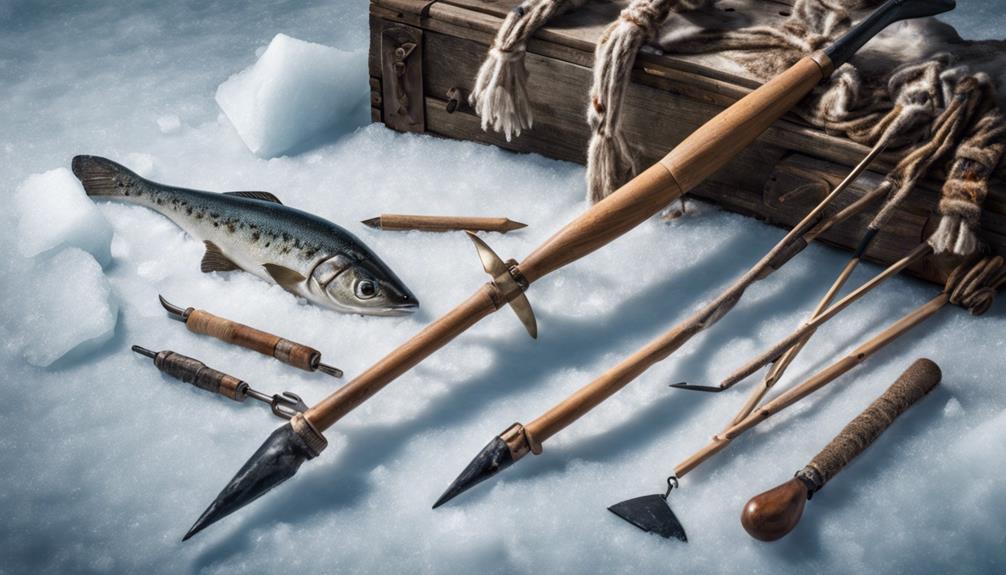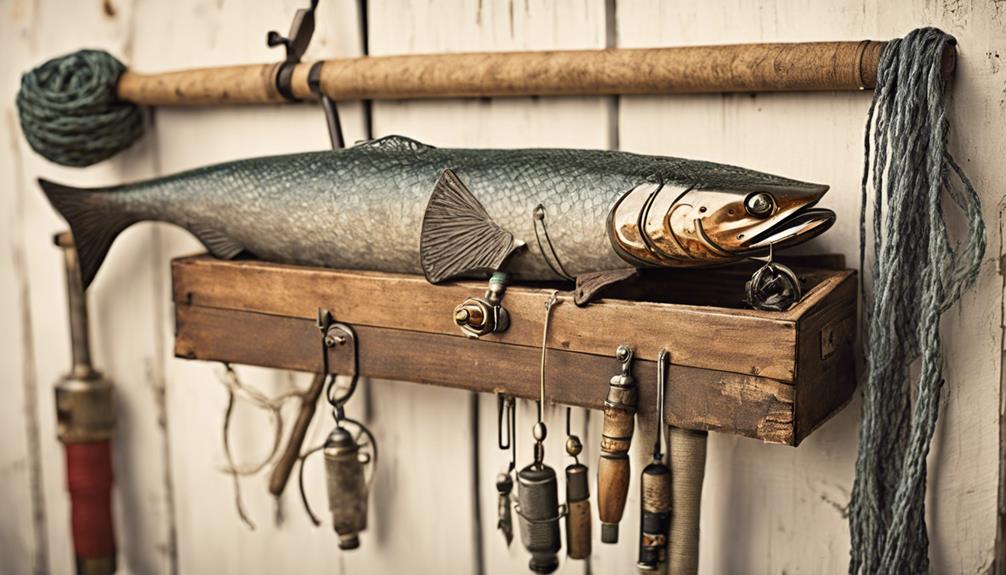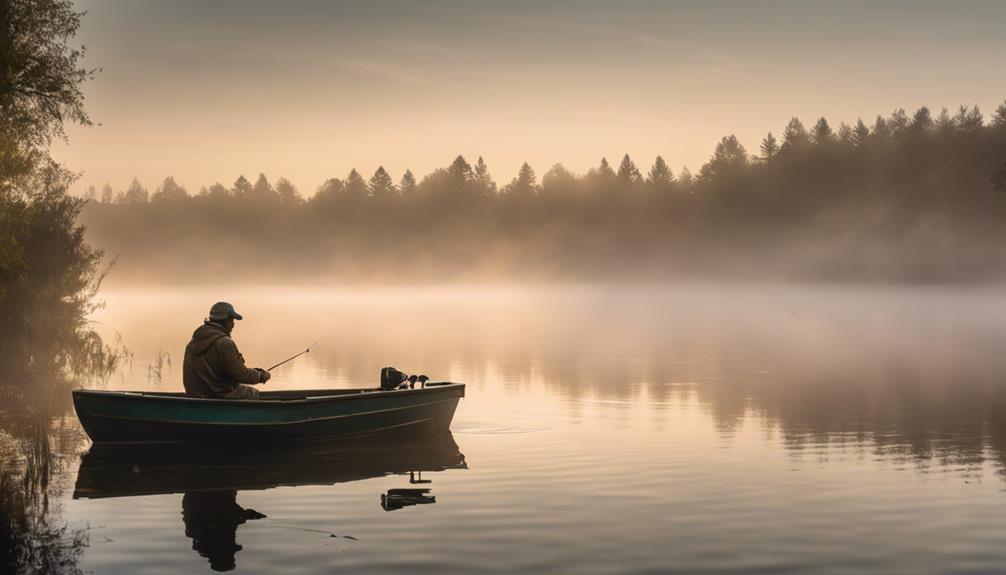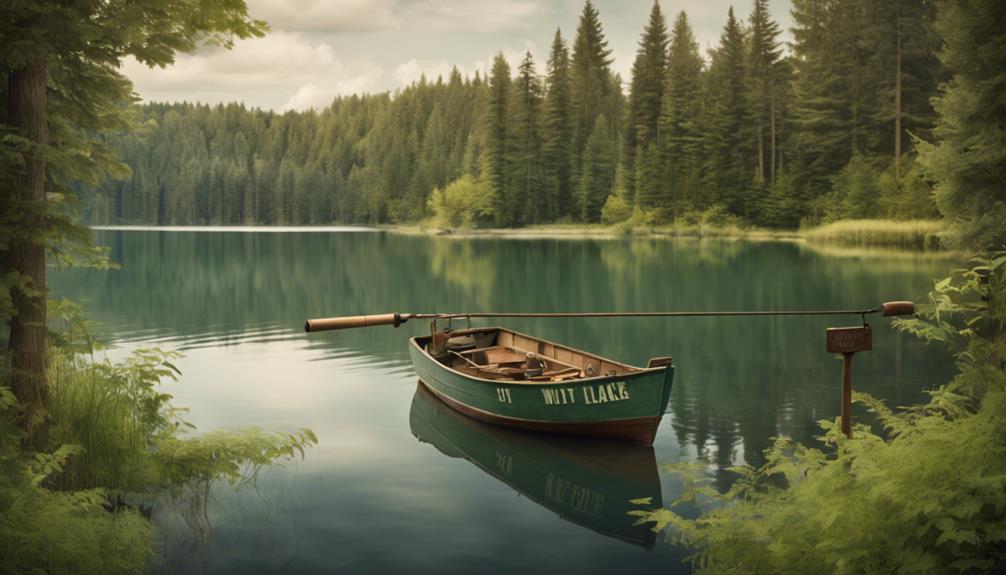Discover the diverse and detailed world of historic angling techniques and tools. From ancient fishing nets to traditional bait, delve into the past to uncover unique insights into how our ancestors caught their prized fish.
Learn about early fishing hooks and lines, as well as classic fly fishing approaches that have stood the test of time. These 13 tips will transport you back in history while providing valuable knowledge that can enhance your angling skills today.
Early Fishing Hooks and Lines
When angling in ancient times, fishermen crafted hooks and lines from natural materials readily available in their surroundings. The evolution of line construction and development of hook materials played crucial roles in the historical usage of fishing lines and the creation of ancient hook designs. Initially, fishing lines were made from plant fibers, animal sinew, or even hair. These lines evolved over time, becoming more durable and efficient through the use of materials like silk, horsehair, and eventually nylon in modern times.
Ancient hooks were fashioned from a variety of materials such as bone, wood, and metal. Fishermen meticulously carved and shaped these materials into hooks of different sizes and designs to suit various fishing needs. As time progressed, hooks became more specialized, with intricate barbs and shapes to improve their effectiveness in catching fish. The development of metal hooks revolutionized fishing, providing anglers with stronger and more reliable tools for their trade.
The historical significance of fishing lines and hook designs can't be understated. They represent the ingenuity and resourcefulness of early fishermen who relied on their skills to provide sustenance for themselves and their communities. Through the continuous evolution of line construction and hook materials, fishing techniques advanced, leading to more successful and efficient angling practices that have stood the test of time.
Ancient Fishing Nets and Traps
Ancient fishermen ingeniously devised intricate fishing nets and traps to enhance their catch efficiency and expand their harvesting capabilities. These ancient methods showcased remarkable innovation and resourcefulness in capturing aquatic bounty. Here are four fascinating examples of ancient fishing nets and traps:
- Underwater Spearfishing Techniques: In ancient times, skilled fishermen would use sharpened spears to hunt fish beneath the water's surface. This method required precision and patience, allowing them to target specific fish species for their sustenance.
- Ancient Fish Traps: Fishermen would construct elaborate traps using natural materials like reeds, vines, and branches. These traps were strategically placed in waterways to lure fish into enclosed spaces, making it easier for fishermen to harvest their catch.
- Traditional Handline Fishing: Handline fishing, a simple yet effective method, involved using a single fishing line with a baited hook. Fishermen would skillfully maneuver the line to attract fish, showcasing their expertise in the art of angling.
- Historic Cast Nets: Cast nets were widely used in ancient times for catching large quantities of fish in one throw. Fishermen would skillfully cast the net over a school of fish, quickly ensnaring them as the net sank beneath the water's surface.
These ancient fishing nets and traps reflect the ingenuity and adaptability of early fishermen, highlighting their deep understanding of marine ecosystems and fishing techniques.
Traditional Bait and Lures
Reflecting on the innovative techniques of ancient fishermen, traditional bait and lures have long been integral components in enhancing the art of angling. Natural baits, such as worms, insects, and minnows, have been used for centuries to attract fish. These baits are effective in enticing a wide variety of species due to their natural scent and appearance.
On the other hand, artificial lures crafted from materials like feathers, metal, and plastic have gained popularity for their versatility and durability. Anglers often choose lures that mimic the movements of prey to trigger the predatory instincts of fish.
In addition to bait and lures, handmade bobbers play a crucial role in traditional angling. These floating indicators help anglers detect when a fish has taken the bait, allowing for timely hooksets. Crafted from materials like cork, wood, or plastic, bobbers have evolved over time but remain essential tools in fishing.
Moreover, historic reels, whether simple handcrafted designs or more complex mechanisms, have been used to control the fishing line and retrieve catches. These reels showcase the craftsmanship and ingenuity of past anglers, contributing to the rich history of fishing.
Historic Fishing Rod Designs
Crafted with precision and innovation, historic fishing rod designs exemplify the artistry and functionality of early angling equipment. Through the centuries, rod building evolution has been influenced by various cultures, resulting in a diverse range of designs that showcase both practicality and beauty.
Here are some key elements that define historic fishing rod designs:
- Indigenous Influences: The rod building techniques of indigenous communities around the world have significantly contributed to the evolution of fishing rods. These designs often reflect the specific fishing practices and environments of different cultures, incorporating unique features that enhance performance.
- Material Advancements: From the early days of using bamboo and wood to the more recent introduction of fiberglass and carbon fiber, material advancements have played a crucial role in shaping fishing rod designs. Each material offers distinct characteristics that impact the rod's action, sensitivity, and durability.
- Decorative Elements: Many historic fishing rods aren't just tools for angling but also works of art. Intricate carvings, engravings, and embellishments adorn these rods, adding a touch of elegance and personalization to each piece.
- Functional Design: Beyond aesthetics, historic fishing rods were designed with a keen focus on functionality. The length, flexibility, and taper of the rod were all carefully considered to optimize casting distance, accuracy, and control while fishing in different conditions.
Primitive Fishing Boats and Rafts
The evolution of historic fishing rod designs has paved the way for the development of primitive fishing boats and rafts, essential tools that early anglers relied upon for navigating waters and accessing prime fishing spots. Raft construction in ancient times varied depending on the available resources and the specific needs of the angler. Some rafts were simply logs tied together, while others were more sophisticated with added features like seats or storage compartments. These rafts were typically crafted using materials such as wood, reeds, or animal skins, showcasing the resourcefulness of early fishermen.
When it comes to fishing techniques used on these primitive boats and rafts, anglers employed a variety of methods to catch fish. One common technique was using hand lines or simple fishing rods with baited hooks to lure fish. The mobility provided by the rafts allowed anglers to explore different parts of the water and find the best fishing spots. Additionally, some fishermen used nets to catch larger quantities of fish, taking advantage of the stability and space offered by the rafts.
Ancient Fishing Techniques for Rivers
Ancient anglers skillfully employed a range of fishing techniques specifically tailored for rivers to maximize their catch. When fishing in rivers, they utilized methods that took advantage of the flowing water and the unique behaviors of river-dwelling fish. Here are some past angling techniques that were commonly used for stream fishing:
- Spearfishing: Ancient anglers would stand in shallow river waters, patiently waiting for fish to swim by before swiftly spearing them with sharpened sticks or bone-tipped spears.
- Netting: They'd strategically position nets across river channels or at confluences to trap fish as they moved with the current, providing a bountiful catch.
- Trapping: Constructing woven traps or weirs made of branches and vines, they created barriers in the river to direct fish into holding areas where they could easily be retrieved.
- Angling with Natural Bait: Using insects, small fish, or even parts of captured fish as bait, ancient anglers would skillfully cast lines made of plant fibers or animal sinew to entice fish lurking in river pools.
These techniques required a deep understanding of the underwater environment and the behavior of river fish, showcasing the ingenuity and resourcefulness of ancient anglers in their quest for a successful catch.
Time-honored Ice Fishing Methods

Utilizing innovative techniques passed down through generations, ice fishing has long been a revered practice among skilled anglers in colder regions. When venturing onto frozen lakes or rivers for ice fishing, constructing a sturdy ice shelter is crucial for both comfort and survival. These shelters provide protection from harsh winds and freezing temperatures, allowing anglers to focus on their craft without succumbing to the elements.
In winter, certain fish species exhibit unique habits that make them more susceptible to ice fishing methods. Species such as trout, walleye, and perch tend to gather in specific areas under the ice, making them prime targets for ice anglers. Understanding the behavior and movements of these winter fish is essential for a successful ice fishing expedition.
To maximize your chances of a good catch, consider using tip-ups or jigging rods when ice fishing. Tip-ups are devices that signal when a fish bites, while jigging rods allow you to maneuver bait in a way that attracts fish. Patience is key when ice fishing, as the cold temperatures can slow down fish activity.
Remember to dress warmly, bring essential safety gear, and always check the ice thickness before setting up your fishing spot. By respecting nature and honing your ice fishing skills, you can partake in this time-honored tradition with confidence and success.
Classic Fly Fishing Approaches
When you venture into the realm of classic fly fishing approaches, your angling skills will be put to the test in a whole new way. Whether you're casting a wet fly or delicately presenting a dry fly, mastering these techniques can greatly enhance your fishing experience.
Here are some tips to help you navigate the world of classic fly fishing:
- Wet Fly vs. Dry Fly: Understand the distinction between wet flies that sink below the surface and dry flies that float on the water's surface. Knowing when to use each type based on the feeding patterns of the fish is crucial for success.
- Stream Fishing: In streams, focus on presenting your fly in a natural way by mimicking the insects that fish feed on. Pay attention to the current and practice casting accuracy to target specific areas where fish are likely to hide.
- Lake Fishing: When fly fishing in lakes, observe the water for rising fish or use sinking lines to reach deeper waters where fish might be lurking. Experiment with different retrieval techniques to entice lake-dwelling fish.
- Matching the Hatch: Study the insects prevalent in the area and select fly patterns that closely resemble them. Matching the hatch increases the chances of attracting fish, making your fly more enticing and effective.
Frequently Asked Questions
How Did Ancient Anglers Determine the Best Times and Locations to Fish?
You figured out the best times and spots for fishing by observing lunar phases and celestial cues, like the position of the moon and stars.
Natural signs and environmental indicators, such as the behavior of birds or the movement of fish, also guided your decisions.
Were There Any Specific Rituals or Ceremonies Associated With Fishing in Ancient Cultures?
In ancient cultures, fishing wasn't just about catching food; it was a sacred practice. Ceremonial practices and rituals were deeply intertwined with fishing, creating spiritual connections to the natural world.
These rituals often involved offerings to the water or prayers to the gods of the sea. Fishing wasn't just a means of survival; it was a way to honor the elements and show respect for the cycle of life.
What Were Some Common Superstitions or Beliefs Related to Fishing in Historical Times?
When it comes to fishing omens and luck charms from historical times, anglers held onto various superstitions.
Some believed that carrying a rabbit's foot would bring good fortune or that seeing certain birds like herons meant a successful catch was near.
Others thought that whistling on a boat would scare away the fish.
These beliefs added an extra layer of mystique to the ancient art of fishing.
How Did Ancient Anglers Handle and Preserve Their Catches Without Modern Refrigeration?
When ancient anglers caught fish, they used various food preservation techniques to handle and preserve their catches without modern refrigeration. Methods like salting, smoking, and drying were common practices.
Were There Any Specific Rules or Regulations Governing Fishing in Different Historical Periods or Regions?
In different historical periods and regions, fishing regulations varied. Ancient times saw regional fishing rules that dictated catch limits, fishing methods, and protected species. These rules aimed to ensure sustainable fishing practices and preserve aquatic ecosystems.
Understanding the specific regulations of the time and place you're fishing in is crucial to respecting historical fishing traditions and contributing to the conservation of marine life.
Conclusion
So next time you're out on the water, consider trying out some of these historic angling techniques and tools. You might just find a new appreciation for the ancient art of fishing and catch some fish in the process.
Remember, the past holds valuable lessons that can enhance your fishing experience today. Happy fishing!



